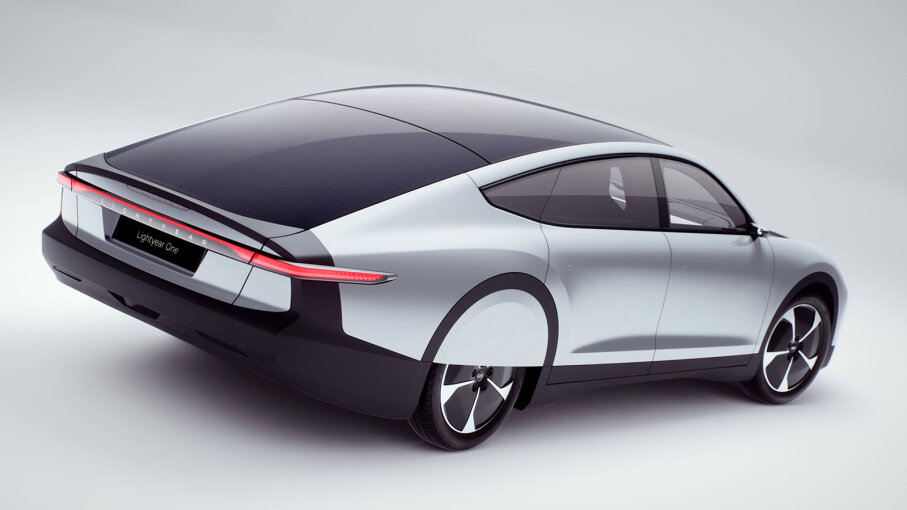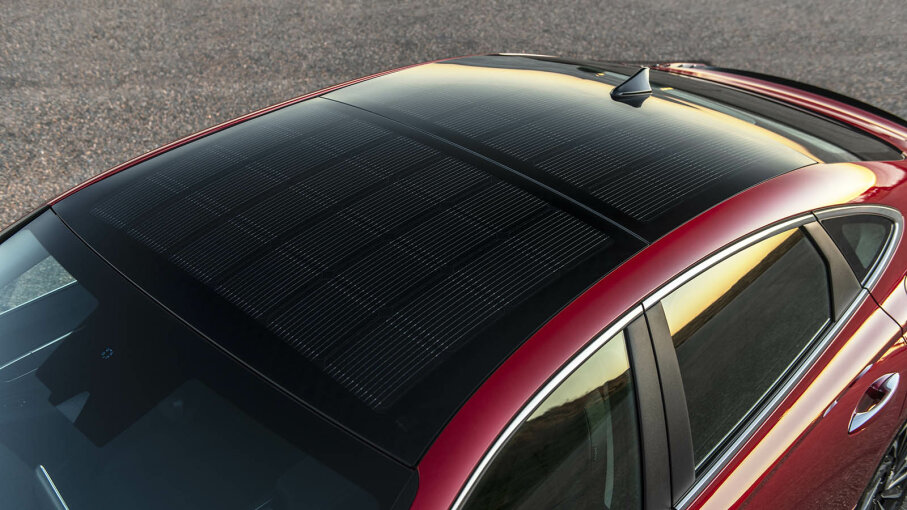
.................................................................................................................................................
 |
| The roof and hood of the Lightyear One are comprised of integrated solar cells so the car can charge itself whenever it absorbs sunlight. |
Solar Panels Are Slowly Making Their Way on Cars
BY
CRISTEN CONGER & CHERISE THREEWITT
There may be no such thing as a free lunch,
but what about a free ride?
Think of how awesome it would be if your car
could keep running without you spending a dime on fuel.
If you drove a solar-powered car that dream
could be a lot closer to a reality.
Much like solar-powered homes, solar cars
harness energy from the sun, and then convert it into electricity.
That electricity then fuels the car's
powertrain, which is similar to the combination of an electric motor and
battery-based energy storage that drives modern hybrid cars.
Solar cars can accomplish this through
photovoltaic cells (PVC).
PVCs are the components in solar paneling
that convert the sun's energy to electricity. They're made up of
semiconductors, usually made of silicon that absorb the light.
The sunlight's energy then frees electrons in
the semiconductors, creating a flow of electrons. That flow generates the
electricity that powers the battery or the specialized motor in solar cars.
The earliest solar cars were DIY jobs that
date back to the 1970s and were mostly designed and assembled in car
enthusiasts' garages.
Several other organizations experimented with
race cars designed to take advantage of solar power.
These helped engineers understand the
potential — and the limitations — of collecting and storing solar energy,
maximizing aerodynamics and identifying other challenges to running a car
powered off the sun.
As for major auto manufacturers'
contributions to the field, Ford and Mazda, notably, both introduced solar
hybrid concept cars in the mid-2000s, and Cadillac designed a concept car that
used solar panels to help power accessories like interior lighting and audio
that typically draw off a car's electrical system (which, in turn, contributes
to fuel consumption).
None of these concept cars made it to
production, which means they were never available to consumers.
After that, investment in solar car
technology more or less went dark, at least as a mainstream pursuit.
On the upside, though, many automakers have shifted
development resources toward making hybrid and plug-in hybrid cars more
practical, efficient and affordable than ever.
This, in turn, means it might be time to give
solar cars another shot, though the new-generation solar cars on the horizon
are more like hybrids that add solar power to the mix.
Are Solar-powered Cars Practical?
 |
| The 2020 Hyundai Sonata Hybrid features a Solar Roof System that recharges the car's hybrid battery and increases the car's driving range by a couple of miles a day. |
In other words, it's easier and more affordable
than ever for consumers to go buy a readily available electric or hybrid car,
and these cars are more efficient, easier to charge, and have fewer compromises
overall than EVs and hybrids of just a couple generations ago.
That means there are more people who can take
advantage of solar power to run a car, and that solar power will literally go
farther than it would have in the past.
That said, solar panel technology has
improved, too.
It's more affordable and easier for most
consumers to incorporate into a home or garage update. But solar-powered cars
still have a long way to go.
In fact, it's unlikely that we'll see a car
that can be fully powered by a solar panel integrated into the roof, because a
panel that size is just too small to produce the power needed.
EnergySage, a company that helps consumers
research and shop for solar technology, estimates that a car completely covered
in solar panels (not just the roof) could only power an electric car for a
maximum of 25 miles (40 kilometers) a day, and that's assuming weather and
other conditions are absolutely perfect.
Yet, EnergySage argues a solar panel that
gives a car a boost of just a few miles a day is still worth the investment.
So which automakers are investing in the
technology?
There are several. High-tech company
Lightyear released two Lightyear Research Vehicles to test its integrated solar
technology on the road in June 2020.
The company says it is preparing to produce
an exclusive series of cars equipped with its solar technology by the end of
2021.
Germany's Sono Motors has spent three years
developing a manufacturing process that will enable the seamless integration of
solar cells into the body of its Sion electric car.
On June 30, 2020, the company announced it
had partnered with Roding Automobile GmbH to begin production of its next
generation of Sion prototypes.
Toyota is testing a version of the Prius with
an integrated solar roof in Japan.
This demo version, which is not for sale, can
charge the car while it is being driven; its earlier version could only charge
while parked.
The 2020 Hyundai Sonata Hybrid, however, is
available to American consumers and comes with a solar roof panel that
recharges the car's batteries.
The roof panel generates enough electric
power to increase the car's driving range by about 2 miles (3.2 kilometers) a
day.
The Tesla Cybertruck, which was unveiled in
November 2019 but isn't expected to be released until late 2021, has an option
for solar panels, even though Tesla CEO Elon Musk has previously said that
solar panels on cars are too inefficient.
And that brings us to the question of whether
or not the extra cost of adding solar panels to a car is worth it.
For example, cars in sunnier locations and
cars that are parked outside rather than in a garage, will generate more solar
power and offer more of a financial benefit to owners.
But the question still remains to be seen
whether the financial costs to automakers will be beneficial enough to produce
them.
DIY solar panel kits that are designed to
contribute to powering the battery of an electric or plug-in hybrid car via the
home's charging system are available.
Similar aftermarket kits are offered and
marketed as ways to help power RVs or trailers.
They can also be used to collect and store
energy for camping accessories such as tents or cooking setups, like those
designed to mount in the bed of a pickup truck.
 |
| Tesla's Cybertruck has optional solar panels, which can be used to power things like its camping equipment. |
As for now, though, adding solar panels
directly to your car isn't very common. Though they may someday become more
plausible for more consumers.
SOLAR CAR COMPETITIONS
Solar car racing has been going on since the
1980s, long before today's consumer-focused efforts at getting solar cars on
the road.
The 1,872-mile (3,012-kilometer) World Solar
Challenge began in 1983 and races across Australia every two years.
The American Solar Challenge started in 1990
and follows a route across North America that changes almost every year.
About
Cristen Conger
Raised
on a steady diet of Technicolor musicals and library books, Cristen Conger
always wanted to be a writer when she grew up. While working toward her
journalism degree at the University of Georgia, she learned to avoid
starry-eyed statements about childhood dreams and stick to hard facts. After
graduating, Cristen decided she'd spent enough time chasing down REM band
members in Athens and hitched up the road to Atlanta where she jumped on board
with the award-winning web site HowStuffWorks.com.
As
a writer and blogger for HowStuffWorks and a contributing writer for Discovery
News, Cristen specializes in technology and the science of everyday living. Her
articles have featured on Huffington Post, ABC Science and MSNBC.com. She also
co-hosts the popular Stuff Mom Never Told You podcast, which explores gender
issues such as relationships, careers and women's history. A graduate of
University of Georgia, where she majored in journalism, Cristen reads, writes,
runs and dabbles in improv comedy.
Cherise
Threewitt
CONTRIBUTING
WRITER
Cherise
Threewitt is a Chicago-based writer and editor with 15 years of experience
covering the automotive industry. At HowStuffWorks, Cherise enjoys researching
and writing stories that make cars and car culture interesting and accessible
for everyone. When Cherise isn't writing, she's probably at the gym, paddling
on Lake Michigan, or driving her 2019 Subaru WRX.


No comments:
Post a Comment